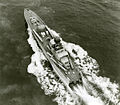 HSwMS Spica at sea. | |
| History | |
|---|---|
| Name | HSwMS Spica |
| Namesake | Spica |
| Builder | Götaverken AB |
| Launched | 24 June 1966 |
| Decommissioned | 1989 |
| Identification | T121 |
| Status | Museum ship since 1989 |
| General characteristics | |
| Class & type | Spica-class fast attack craft (FAC) |
| Displacement | 210 tons |
| Length | 42.5 m (139 ft) |
| Beam | 7.1 m (23 ft) |
| Draught | 2.6 m (8 ft 6 in) |
| Propulsion | Three Bristol Proteus 4,250 HP gas-turbines driving 3 hydraulically controllable pitch screws |
| Speed | 40 knots+ |
| Complement | 30 |
| Armament | 1× Bofors 57 mm gun, 6× 533 mm (21.0 in) wire-guided torpedoes, 2× 7.62×51mm NATO machine guns, Flare and chaff rockets, naval mines and/or depth charges |
HSwMS Spica (T121) is a former Swedish Navy Spica-class, torpedo-armed, fast attack craft (FAC), now a museum ship at the Vasa Museum in Stockholm, Sweden.




